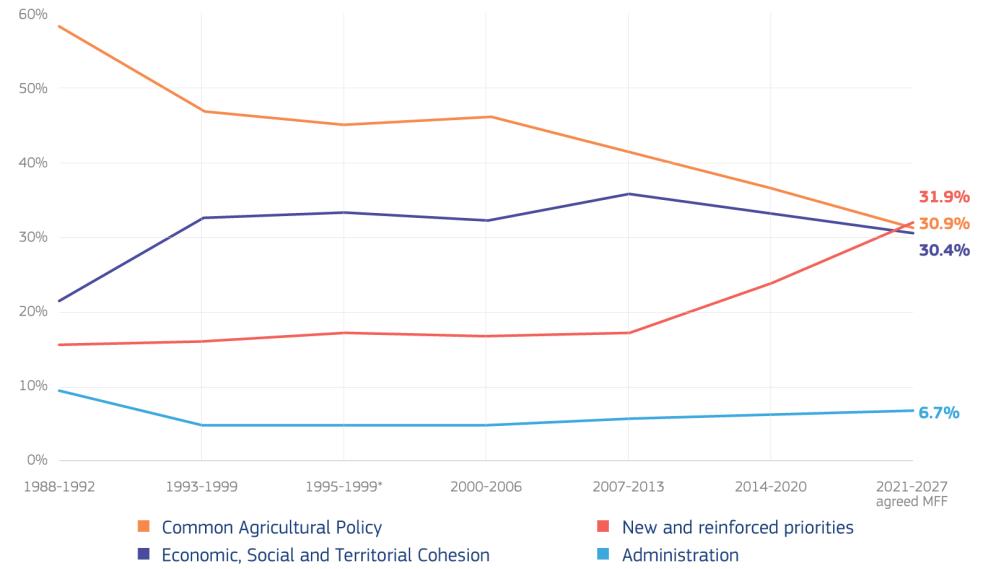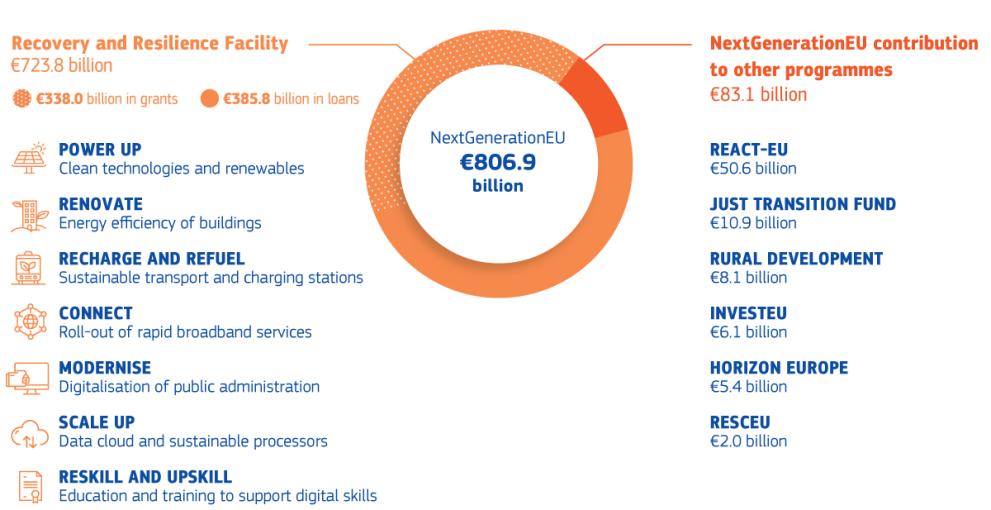We asked EU budget opinion leaders what the EU budget of the future should look like. Here is what they said, and keep reading to learn more about the already modernised 2021-2027 long-term budget and the NextGenerationEU recovery instrument.
Views expressed in the videos are personal views of the speakers based on their professional background. They do not represent the views of the organisation they represent.
Revision of the EU budget 2021-2027
Since the adoption of the 2021-2027 long-term EU budget in 2020, the EU has faced unprecedented and unforeseen crises: from Russia’s war of aggression against Ukraine and its consequences, to the acceleration of inflation and interest rates, to migration and external challenges such as the Middle East Conflict. Tackling these multiple challenges has stretched the resources of the EU budget to the limit, hampering its ability to address even the most pressing challenges. To ensure that the EU budget can continue to deliver on its key objectives, the European Commission proposed in June 2023 to strengthen the EU's long-term budget.
On 1 February 2024, EU leaders endorsed all the priorities of the Commission's proposal and agreed on the first-ever revision of the EU's long-term budget – which was also approved by the European Parliament on 27 February 2024. The key elements include:
- Critical support for Ukraine: A new Ukraine Facility, based on grants, loans, and guarantees, with a total capacity of €50 billion over the period 2024-2027, will address Ukraine's immediate needs, reconstruction, and modernisation on its path towards the EU.
- Strengthening sovereignty and competitiveness: The Strategic Technologies for Europe Platform (STEP) will boost the EU's long-term competitiveness in critical technologies, digital and deep tech, clean tech, and biotech, with new flexibilities and incentives for cohesion funding and the Recovery and Resilience Facility, and a €1.5 billion top-up to the European Defence Fund.
- Further action on Migration and external challenges: An increase of €9.6 billion will support the internal and external dimensions of migration and help partners in the Western Balkans, southern neighbourhood and beyond.
- Stronger response to unforeseen crisis: To enable the EU budget to continue to respond to unforeseen circumstances - such as the energy crisis, food crises and the aftermath of Russia’s war amid rising inflation and interest costs – the Flexibility Instrument will be reinforced by €2 billion while the ceiling of the Emergency Aid Reserve will be increased by €1.5 billion and split into two separate instruments: the European Solidarity Reserve and the Emergency Aid Reserve.
- More crisis resilience: A three-step emergency mechanism and a new instrument will provide clarity on the budgetary mechanisms for financing the costs associated with NextGenerationEU.
The revision will be financed through a combination of new resources and redeployment within the EU budget. This will allow the EU to continue to address the most pressing priorities while minimizing the impact on national budgets, to the benefit of European citizens and beyond.
The revision entered into force on 1 March 2024 and applies retroactively to the EU budget since 1 January 2024.
Read the amended regulation here
A modernised EU long-term budget, powered by NextGenerationEU
The EU’s 2021-2027 long-term budget, together with the NextGenerationEU recovery instrument, amounts to €2.018 trillion in current prices (€1.8 trillion in 2018 prices). This unprecedented response will help repair the economic and social damage caused by the coronavirus pandemic and aid the transition towards a modern and more sustainable Europe.
The package consists of the long-term budget, the 2021-2027 multiannual financial framework, made up of €1.211 trillion in current prices (€1.074 trillion in 2018 prices), combined with the temporary recovery instrument, NextGenerationEU, of €806.9 billion (€750 billion in 2018 prices).
Have a look at the comprehensive brochure on MFF 2021-2027 and NextGenerationEU

This is a truly modernised budget:
- More than 50% of the total amount of the next long-term budget and NextGenerationEU will support the modernisation of the European Union through research and innovation; fair climate and digital transitions; preparedness, recovery and resilience
- 30% of the EU budget will be spent to fight climate change. The package also pays specific attention to biodiversity protection and gender-related issues
- 20% of NextGenerationEU will be invested in the digital transformation
- In 2026 and 2027, 10% of the annual spending under the long-term budget will contribute to halting and reversing the decline of biodiversity
- For the first time ever, new and reinforced priorities have the highest share within the long-term budget, 31.9%.
Share of the main policy areas in the Multiannual Financial Frameworks:

NextGenerationEU: €800 billion for Europe's recovery
NextGenerationEU is a €806.9 billion temporary recovery instrument in current prices, which will be channelled through the EU’s long-term budget, particularly in the years 2021-2023.
The money from NextGenerationEU will be invested across several programmes, and will be distributed to EU countries and beneficiaries through grants (€407.5 billion) and loans (€385.8 billion), in current prices.

The majority of funds from NextGenerationEU (€723.8 billion in current prices) will be spent through the Recovery and Resilience Facility (RRF) programme. The RRF consists of large-scale financial support to public investments and areas such as green and digital projects. The support will be given out in the form of grants (€338.0 billion) and loans (€385.8 billion), in current prices.
The grant component of the RRF is divided among EU countries according to several allocation criteria. These include Gross Domestic Product (GDP) per capita, unemployment levels, population and the impact of the coronavirus crisis. Part of the allocation will be calculated later on, to take into account the loss in real GDP over 2020 and cumulatively over 2020-2021.
In order to receive support from the RRF, EU countries need to submit Recovery and Resilience Plans to the Commission, where they explain how they will spend the money. These plans need to take into account the challenges identified in the European Semester, as well as ones related to the green and digital transitions. The Commission will assess these plans and the European Council will then approve them. Money will be disbursed upon the achievement of milestones and targets Member States have themselves committed to.
Recovery and Resilience Facility (RRF)
Recovery and Resilience Scoreboard
Funding NextGenerationEU
The EU budget is about creating common added value and making sure the EU has resources to deliver on its priorities. Would you put your own money into it? We asked EU budget opinion leaders to have their say. Watch the videos to see what they said, and keep reading for the facts and figures on EU budget revenue and expenses.
Views expressed in the videos are personal views of the speakers based on their professional background. They do not represent the views of the organisation they represent.
To raise the necessary funds for NextGenerationEU, the Commission will borrow on the capital markets on behalf of the EU, for up to around €800 billion in current prices.
To preserve its high credit rating and obtain favourable market conditions for borrowing, the Commission will use the headroom of the EU budget. The headroom is the difference between the maximum amount of funds that the EU can request from Member States to cover its financial obligations (own resources ceilings) and the maximum amount of funds that can be spent in a given period (long-term budget payment ceilings). The headroom will serve as a guarantee that the EU will be able to make repayments under any circumstances.
The timing, volume and maturity of the bonds issued will depend on the needs of the EU and its Member States. The funds raised will be repaid from future EU budgets or by the Member states concerned, by 2058 at the latest.
More about the EU’s own resources ceilings
More about the long-term budget payment ceilings
New sources of revenue to ease the burden on Member States
To help repay the borrowing, new own resources will be introduced to complement Member States' contributions to the EU budget.
These would better align the sources of revenue to the EU budget with the EU priorities and objectives. They will help tackling climate change and ensuring fair taxation in an increasingly digital economy.
The first new own resource, already as of 1 January 2021, is a new contribution based on non-recycled plastic packaging waste.
In December 2021, the Commission proposed three new sources of revenue for the EU budget and is working towards their swift introduction.
Potential new sources of revenue
Protecting the EU budget
The EU is a community based on the rule of law. Independent national and EU courts make sure rules and regulations are respected and implemented.
The Regulation on a general regime of conditionality for the protection of the Union’s budget is an integral part of the package. It will complement existing tools, and form an additional layer of protection of the EU budget.
This regulation ensures that the Union is better equipped to deal with breaches of the principles of the rule of law that affect or risk affecting the EU budget. It covers both the long-term budget and the NextGenerationEU instrument.
Rule of law conditionality regulation
Brexit Adjustment Reserve
A €5 billion Brexit Adjustment Reserve will support the countries and economic sectors hardest hit by departure of the United Kingdom from the EU.
The Reserve will assist regions and local communities, including those dependent on fishing activities in UK waters. It will also assist public administrations in the proper functioning of border, customs, sanitary and phytosanitary controls.
